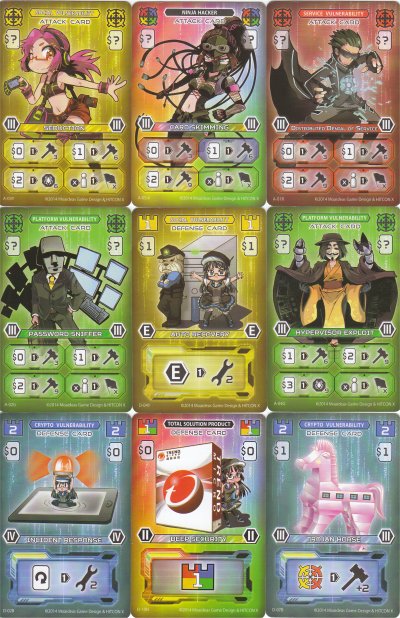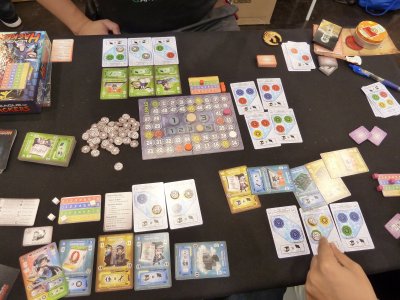

![[IMAGE]](../bilder/lohack1.jpg) |
Designer: Publisher: No. of Players: Awards: |
![[IMAGE]](../technik/box/rot/rot-6.gif) ![[IMAGE]](../technik/box/gelb/gelb-8.gif) ![[IMAGE]](../technik/box/grun/grun-10.gif) ![[IMAGE]](../technik/box/pink/pink-5.gif) ![[IMAGE]](../technik/box/blau/blau-9.gif) |
|
More and more publishers are discovering cyberspace activities as an interesting thematic background for new games, but many of the known games like Android: Netrunner or the much older Edge City are fully-fledged board- or cardgames with considerable depth and duration. I have tried to remember, but I couldn't come up with a singly speedy cardgame on this topic, and so my interest was piqued when I stumbled upon the new Taiwanese cardgame League of Hackers by Desnet Amane. For me, both the game and its publisher MOAIDEAS GAME DESIGN have been unknown until now, but the theme and the manga-style graphics instantly prompted me to learn more about the game.
So, League of Hackers indeed challenges the players to participate in a cyberspace conflict. In order to protect the web at large, these kinds of virtual conflicts have been restricted to an arena where the members of the Hacker's League can fight for their interest. Building up their own network cluster in the Wargame Arena, the players have to install servers and defense measures, but at the same time it's also important to attack the other players' clusters at crucial moments in order to collect victory points.
The game is played over three rounds which are subdivided into five turns each. At the beginning of each round all players receive a hand of 8 randomly drawn cards from a common deck, and in addition a choice of Server cards will be arranged in a common display so that they can be purchased by the players. These Server cards show two to four security risks ("holes") in up to four different colors, and it will be the aim of the players to keep these holes free of attack damage until the end of a round when victory points can be collected for clean holes. However, points cannot only be scored by defending a player's own servers, but at the same time points will be awarded for successfully placing damage tokens onto other players' servers, and so the players may go for an aggressive or a defensive strategy, but it will be most sensible to try a mixture of both.
The deck of cards available to the players contains Attack and Defense cards, and the players will use their hand-cards for an action and/or for fueling this action. So, the card usage in League of Hackers shows some similarities to games like Race for the Galaxy or San Juan where the cards are also used for actions and payment. However, a major difference to these games can be seen in the fact how the player's actions are handled, since the action of a player is not determined by the type of card(s) chosen, but by one of four action tokens which a player places on top of his chosen cards.
 To understand this better, let's have a look at the organization of an action sequence. At the beginning of a turn, each player secretly choses one of his four action tokens to determine his action for the turn, and then the actions will be revealed and resolved step by step depending on their type. The possible actions are Install (purchase of a Server), Mitigation (server repair), Defense (playing a Defense card) and Attack (attacking other players with an Attack card to distribute damage). If a player has chosen Install or Mitigation, he has to place a number of his hand cards under the action token, and when the action is triggered the cards under the token will be used to pay for the server or the repair action. Attack and Defense work in a similar way, but here the topmost card needs to be the card the player wants to use. All cards placed in addition will be used to pay for the chosen Attack/Defense card, and in case of an Attack the action will cause more damage with every card paid. The use of the action tokens may seem to be unnecessary because the aforementioned games could do without them, but they have a valuable function in League of Hackers. So, the four types of actions are almost always available to the players, not just when they have received a certain hand of cards. This clever trick neatly reduces the influence of drawing luck, since the players always can use their hand cards in the one or other way without waiting for a specific card. In addition, the game's dynamics are kept in balance by the action tokens, because the general orientation towards damaging other players' servers would not work well if the players would be cut off especially from attack and repair actions by bad drawing luck. However, even though the four types of action are generally available, the players face a different type of restriction. So, a new hand of eight cards is only distributed at the beginning of a round, and this effectively means that the players have to play through the five turns of a round with a shrinking hand of cards. This limitation forces the players to make really tough decisions: is it better to purchase an expensive Defense card, or is it more sensible to reinforce an Attack card with some valuable other cards in order to cause damage to the servers of some carefree opponent. Or, is it even better to use them more economical, keeping some cards back in order to use them in later turns. The players need a good timing in order to choose a fitting moment for each of their actions, and they do well to keep an eye on the number of cards available to their opponents in order to make a guess at their next move.  As said, Attack cards will be used to distribute damage tokens onto the holes in the other player's servers, and the color of the holes attacked depends on the color of the used Attack card. However, a cautious player may have installed some Defense cards, and these cards will give him a defense capability for one or more colors. The strength of an attack always is modified by the victim's defense capability of the same color, and only excess damage will be placed on the victim's server. All Defense cards remain permanently with the player who has installed them, and apart from increasing the player's defense capability these cards also list special card effects which are useful for the actions of the card's owner. So, each "Incident Response" card owned will increase the efficiency of a Mitigation action, whereas a "Trojan Horse" will increase the amount of damage dealt during an attack which uses a color specified on the card. "Auto Recovery" cards on the other hand will allow their owner to reduce server damage by the end of the round, and "Deep Security" increases a player's defense capabilities in all colors. Ten different types of Defense cards exist in League of Hackers, and the players are challenged to install a wise combination which protects their servers and boosts actions against other players at the same time. There is no real warm-up phase in League of Hackers - the players start attacking each other right from the beginning. Like in a good trick-taking game, the dynamics found in League of Hackers are quite remarkable, with the players warring to get the upper hand in this virtual conflict. To give players who have fallen behind a chance to get back into the game, the total amount of damage which can be placed on servers is limited and in addition all damage will be removed by the end of each round after the distribution of victory points. But despite all this protection a heedless player still faces a hard time if he presents himself too open for other players' attack actions, and so everybody needs to watch his back for the whole virtual duel. As a matter of fact, the fusion of a high degree of action with a nicely fitting theme is a big plus of League of Hackers, because many other cardgames with such a high degree of player interaction usually are quite abstract. Here League of Hackers is a real difference, and it should be hoped that the global distributors will pick up the game and make it available for a broader public, since the 80 copies available at the SPIEL '14 were sold out in just one day. | ||
|
| ||

|
|

|
|
| ||
|
Impressum / Contact Info / Disclaimer Kulkmann@aol.com
Copyright & copy; 2014 Frank Schulte-Kulkmann, Essen, Germany | ||